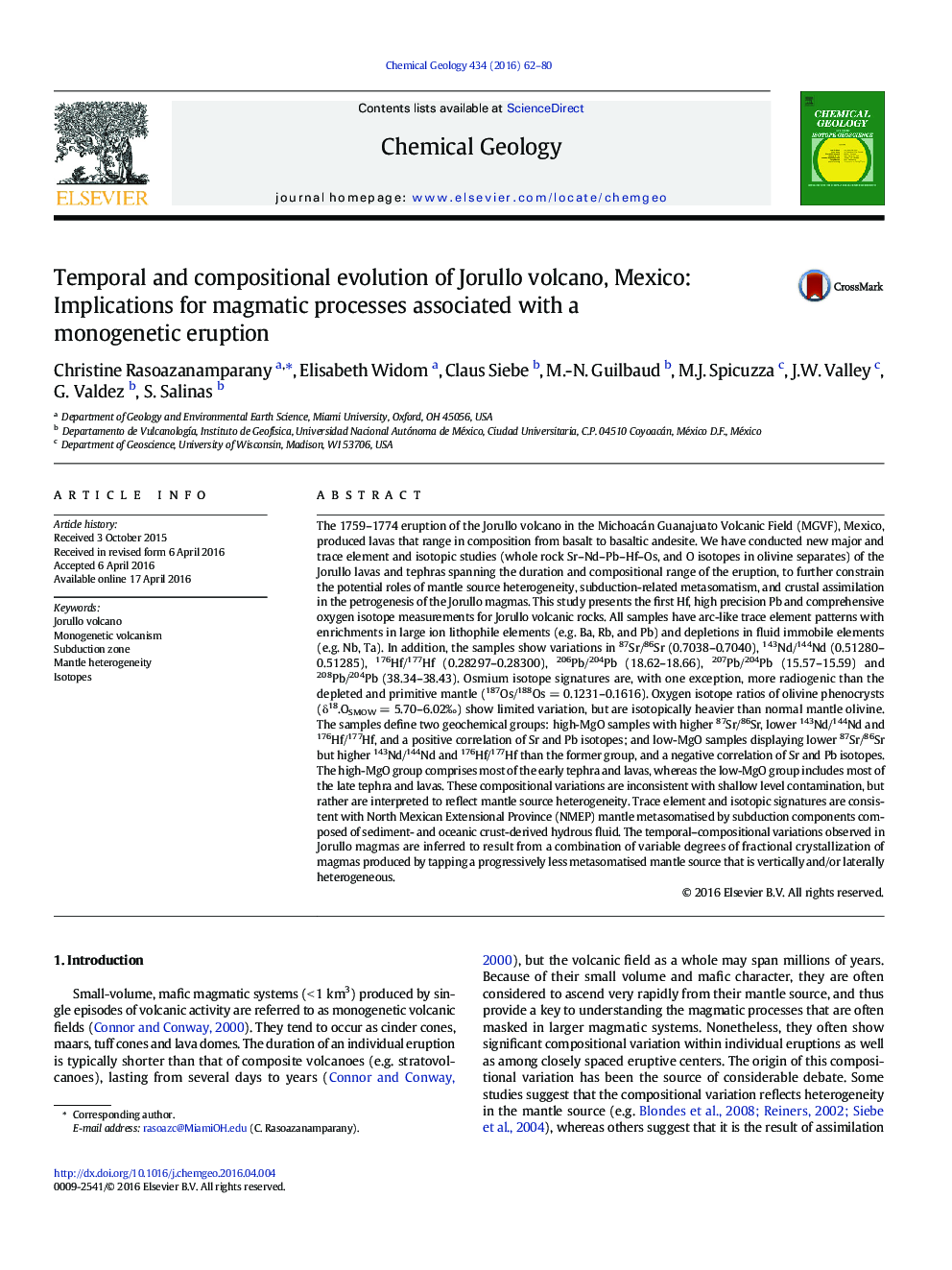| کد مقاله | کد نشریه | سال انتشار | مقاله انگلیسی | نسخه تمام متن |
|---|---|---|---|---|
| 4698274 | 1637540 | 2016 | 19 صفحه PDF | دانلود رایگان |
• Jorullo lavas and tephra show trace element signatures similar to subduction-related magmas.
• Temporal–compositional variation is due to a complex magmatic plumbing system and changes in the mantle source over time.
• The source heterogeneity was produced by a single mantle source fluxed by two subduction components.
• Both subduction components are strongly dominated by terrigenous sediment-derived fluid.
The 1759–1774 eruption of the Jorullo volcano in the Michoacán Guanajuato Volcanic Field (MGVF), Mexico, produced lavas that range in composition from basalt to basaltic andesite. We have conducted new major and trace element and isotopic studies (whole rock Sr–Nd–Pb–Hf–Os, and O isotopes in olivine separates) of the Jorullo lavas and tephras spanning the duration and compositional range of the eruption, to further constrain the potential roles of mantle source heterogeneity, subduction-related metasomatism, and crustal assimilation in the petrogenesis of the Jorullo magmas. This study presents the first Hf, high precision Pb and comprehensive oxygen isotope measurements for Jorullo volcanic rocks. All samples have arc-like trace element patterns with enrichments in large ion lithophile elements (e.g. Ba, Rb, and Pb) and depletions in fluid immobile elements (e.g. Nb, Ta). In addition, the samples show variations in 87Sr/86Sr (0.7038–0.7040), 143Nd/144Nd (0.51280–0.51285), 176Hf/177Hf (0.28297–0.28300), 206Pb/204Pb (18.62–18.66), 207Pb/204Pb (15.57–15.59) and 208Pb/204Pb (38.34–38.43). Osmium isotope signatures are, with one exception, more radiogenic than the depleted and primitive mantle (187Os/188Os = 0.1231–0.1616). Oxygen isotope ratios of olivine phenocrysts (δ18.OSMOW = 5.70–6.02‰) show limited variation, but are isotopically heavier than normal mantle olivine. The samples define two geochemical groups: high-MgO samples with higher 87Sr/86Sr, lower 143Nd/144Nd and 176Hf/177Hf, and a positive correlation of Sr and Pb isotopes; and low-MgO samples displaying lower 87Sr/86Sr but higher 143Nd/144Nd and 176Hf/177Hf than the former group, and a negative correlation of Sr and Pb isotopes. The high-MgO group comprises most of the early tephra and lavas, whereas the low-MgO group includes most of the late tephra and lavas. These compositional variations are inconsistent with shallow level contamination, but rather are interpreted to reflect mantle source heterogeneity. Trace element and isotopic signatures are consistent with North Mexican Extensional Province (NMEP) mantle metasomatised by subduction components composed of sediment- and oceanic crust-derived hydrous fluid. The temporal–compositional variations observed in Jorullo magmas are inferred to result from a combination of variable degrees of fractional crystallization of magmas produced by tapping a progressively less metasomatised mantle source that is vertically and/or laterally heterogeneous.
Journal: Chemical Geology - Volume 434, 15 September 2016, Pages 62–80
